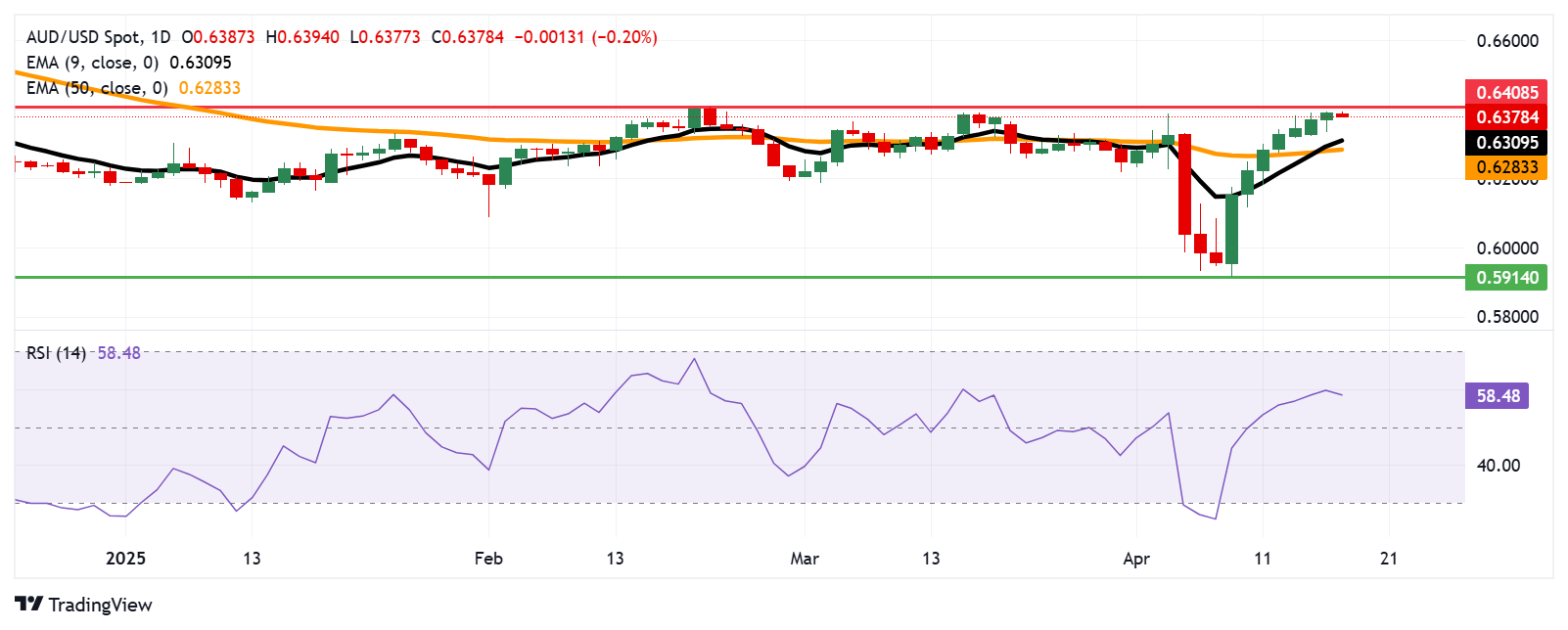Australian Dollar holds losses as trading remains silent on Good Friday
- The Australian Dollar moves little as trading activity remains subdued due to the Good Friday holiday.
- Trump struck an optimistic tone, suggesting a trade deal with China could be finalized within three to four weeks.
- Fed Chair Jerome Powell cautioned that a weak economy combined with sustained inflation could heighten the risk of stagflation.
The Australian Dollar (AUD) remains subdued on Friday following a seven-day winning streak. However, the AUD/USD pair may regain its ground as the US Dollar (USD) weakens amid growing concerns over the economic impact of tariffs on the United States (US). Market participants are closely monitoring developments in US trade negotiations, although trading activity is expected to be subdued due to the Good Friday holiday.
On late Thursday, US President Donald Trump stated that China had made multiple overtures and added, “I don’t want to go higher on China tariffs. If China tariffs go higher, people won’t buy.” Trump expressed optimism that a trade agreement with China could be reached within three to four weeks.
The AUD received a boost after President Trump announced exemptions for key technology products from the newly proposed “reciprocal” tariffs. These exemptions—covering items such as smartphones, computers, semiconductors, solar cells, and flat-panel displays—favor goods predominantly produced in China, Australia’s largest trading partner and a significant consumer of its commodity exports.
Reserve Bank of Australia’s (RBA) March 31–April 1 Meeting Minutes indicated ongoing uncertainty around the timing of the next interest rate adjustment. Although the Board considered the May meeting a suitable point to review monetary policy, it stressed that no decisions had been made in advance. The Board also pointed to both upside and downside risks facing Australia’s economy and inflation trajectory.
Australian Dollar struggles to hold gains amid subdued trading conditions
- The US Dollar Index (DXY), which measures the USD against a basket of six major currencies, is trading lower at around 99.30 at the time of writing. However, the US Dollar found some support following hawkish comments from Federal Reserve Chair Jerome Powell, who warned that a sluggish economy paired with persistent inflation could challenge the Fed’s objectives and raise the risk of stagflation.
- According to the CME FedWatch tool, money market traders are currently pricing in around 86 basis points of Fed rate cuts by the end of 2025, with the first reduction anticipated in July.
- On the labor front, the US Department of Labor reported Thursday that Initial Jobless Claims fell to 215,000 for the week ending April 12, below expectations and down from the previous week’s revised figure of 224,000 (originally 223,000). However, Continuing Jobless Claims rose by 41,000 to 1.885 million for the week ending April 5.
- The US Consumer Price Index (CPI) inflation eased to 2.4% year-over-year in March, down from 2.8% in February and below the market forecast of 2.6%. Core CPI, which excludes food and energy prices, rose 2.8% annually, compared to 3.1% previously and missing the 3.0% estimate. On a monthly basis, headline CPI dipped by 0.1%, while core CPI edged up by 0.1%.
- Australia’s Unemployment Rate rose to 4.1% in March, slightly below the market forecast of 4.2%. Meanwhile, Employment Change came in at 32.2K, against the consensus forecast of 40K.
- Australia’s Westpac Leading Index’s six-month annualised growth rate, which forecasts economic momentum relative to the trend over the next three to nine months, eased to 0.6% in March from 0.9% in February.
- China’s Foreign Ministry stated on Thursday that if the United States continues to engage in tariff-related provocations, China will simply disregard them.
- China’s economy grew at an annual rate of 5.4% in the first quarter of 2025, matching the pace seen in Q4 2024 and surpassing market expectations of 5.1%. On a quarterly basis, GDP rose by 1.2% in Q1, following a 1.6% increase in the previous quarter, falling short of the forecasted 1.4% gain.
- Meanwhile, China’s Retail Sales surged 5.9% year-over-year, beating expectations of 4.2% and up from February’s 4%. Industrial Production also outperformed, rising 7.7% compared to the 5.6% forecast and February’s 5.9% print.
Australian Dollar could test psychological 0.6400 level near four-month highs
The AUD/USD pair is hovering near 0.6390 on Friday, with daily chart indicators pointing to a bullish bias. The pair is holding above the nine-day Exponential Moving Average (EMA), while the 14-day Relative Strength Index (RSI) remains above the neutral 50 mark—both supporting continued upward momentum.
To the upside, the AUD/USD pair could find key resistance at the psychological 0.6400 level, followed by the four-month high of 0.6408, last reached on February 21.
On the downside, initial support lies at the nine-day EMA of 0.6311, with additional support at the 50-day EMA near 0.6283. A break below these levels could weaken the short-term bullish outlook and open the door for a deeper decline toward the 0.5914 zone—its lowest level since March 2020.
AUD/USD: Daily Chart

Australian Dollar PRICE Today
The table below shows the percentage change of Australian Dollar (AUD) against listed major currencies today. Australian Dollar was the weakest against the Japanese Yen.
| USD | EUR | GBP | JPY | CAD | AUD | NZD | CHF | |
|---|---|---|---|---|---|---|---|---|
| USD | -0.10% | -0.05% | 0.00% | 0.00% | 0.18% | 0.00% | 0.00% | |
| EUR | 0.10% | 0.00% | 0.00% | 0.00% | 0.00% | 0.00% | 0.00% | |
| GBP | 0.05% | 0.00% | 0.00% | 0.00% | 0.00% | 0.00% | 0.00% | |
| JPY | 0.00% | 0.00% | 0.00% | 0.00% | 0.30% | 0.33% | -0.11% | |
| CAD | 0.00% | 0.00% | 0.00% | 0.00% | 0.06% | 0.00% | 0.00% | |
| AUD | -0.18% | 0.00% | 0.00% | -0.30% | -0.06% | 0.00% | 0.00% | |
| NZD | 0.00% | 0.00% | 0.00% | -0.33% | 0.00% | 0.00% | 0.00% | |
| CHF | 0.00% | 0.00% | 0.00% | 0.11% | 0.00% | 0.00% | 0.00% |
The heat map shows percentage changes of major currencies against each other. The base currency is picked from the left column, while the quote currency is picked from the top row. For example, if you pick the Australian Dollar from the left column and move along the horizontal line to the US Dollar, the percentage change displayed in the box will represent AUD (base)/USD (quote).






